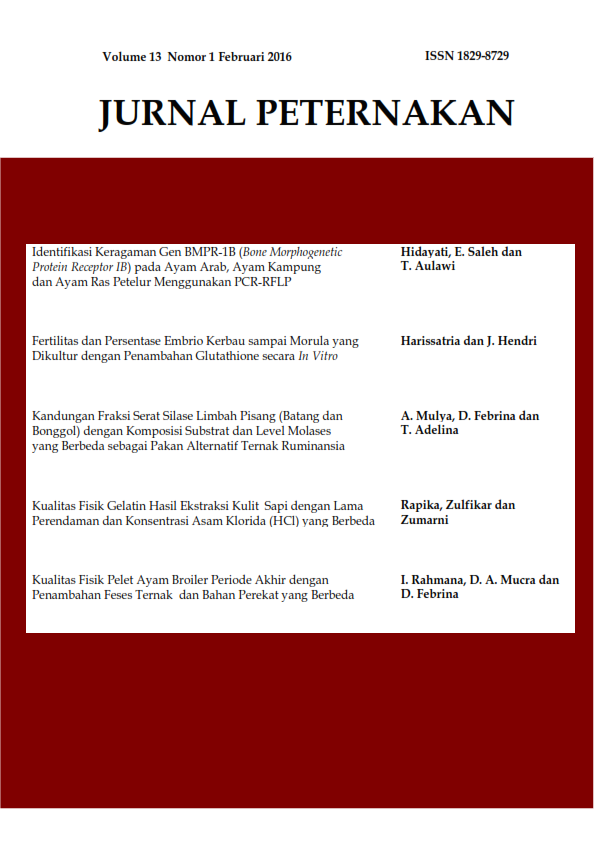IDENTIFIKASI KERAGAMAN GEN BMPR-1B (Bone Morphogenetic Protein Receptor IB) PADA AYAM ARAB,AYAM KAMPUNG DAN AYAM RAS PETELUR MENGGUNAKAN PCR-RFLP
DOI:
https://doi.org/10.24014/jupet.v13i1.2383Keywords:
BMPR-1B gene, PCR-RFLP, native chicken, arab layer chicken, layer chickenAbstract
BMPR-1B gene closely related to the rate of ovulation and follicular maturation. In poultry, BMPR-1B gene is located on chromosome 14th consists of 13 exons. BMPR-1B was expressed in the granulosa cells of the ovary and teca interna poultry. BMPR-1B was able to accelerate the maturation of the follicles so that the ova produced increasingly. BMPR-1B gene diversity was associated with poultry production. DNA isolation was performed using GeneJET Genomic DNA Purification Kit from blood samples derived from 28 native chickens, 20 layer chickens and 10 arab layer chickens. A total of 58 DNA were used as a template in the process of BMPR-IB gene amplification using Polymerase Chain Reaction method. Primers used in this study according to Zhang et al. (2008), Forward primer 5 'ATG GCT GGG AAG TCT GGA TG 3'dan Reverse primer 5' TGC CTT CTG TGT TAA CCG C 3 'with a length of 581 bp. This primary amplify BMPR-1B gene segment from exon 6 to exon 7 including the entire intron 6 with an annealing temperature of 58 0 C. BMPR-IB gene diversity was detected using restriction enzymes HindIII were incubated for 2 hours. The results of the study was showed that Hind III restriction enzymes do not cut the BMPR-1B gene segments in the population of native chickens, arab layer chickens and layer chickens, they were monomorphic.
Downloads
Published
Issue
Section
License
The Authors submitting a manuscript do so on the understanding that if accepted for publication, copyright of the article shall be assigned to Jurnal Peternakan and published by Fakultas Pertanian dan Peternakan Universitas Islam Negeri Sultan Syarif Kasim Riau as publisher of the journal.
Authors who publish with this journal agree to the following terms:
Authors automatically transfer the copyright to the journal and grant the journal right of first publication with the work simultaneously licensed under a Creative Commons (CC BY) that allows others to share the work with an acknowledgement of the work's authorship and initial publication in this journal.
Authors are able to enter into separate permission for non-exclusive distribution of the journal's published version of the work (e.g., post it to an institutional repository or publish it in a book), with an acknowledgement of its initial publication in this journal.
Authors are permitted and encouraged to post their work online (e.g., in institutional repositories or on their website) prior to and during the submission process, as it can lead to productive exchanges, as well as earlier and greater citation of published work (See The Effect of Open Access).

